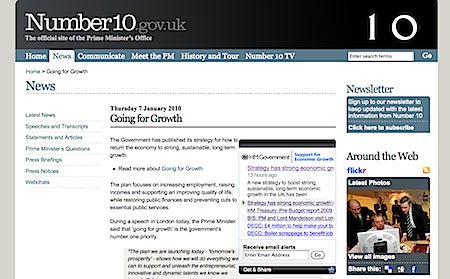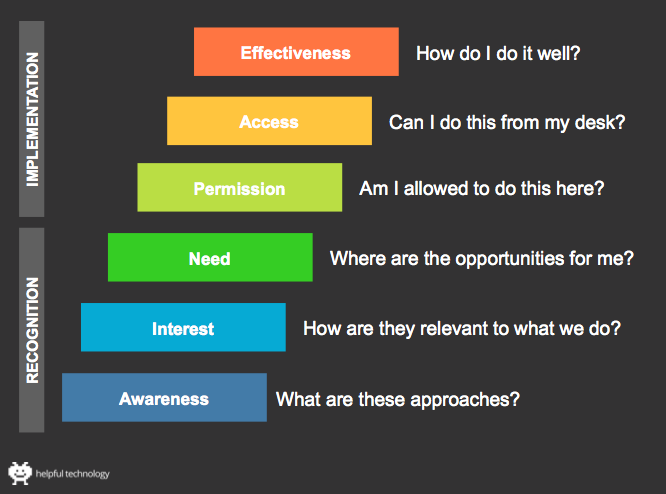If there’s one thing Barack Obama taught us about the power of digital by the manner of his election, it’s that email still counts (and, for that matter, still works when you’re in government). For a while, I’ve been determined to focus more on how we use email as a corporate communication channel, particularly in the context of needing to justify why establishing new websites often isn’t a good idea.
We launched a project at work today that’s hopefully a step in the right direction: a kind of souped-up landing page for our new strategy for supporting economic growth, Going for Growth.
We’re probably not alone in having a few big policy themes which embrace a multitude of announcements, speeches and initiatives. The challenge for digital communications – well, for all communications, I suppose – is bringing these big themes out in ways our audiences can understand, and not losing the wood for the trees. Even on our own small interim site, thematic information is scattered across press releases, speeches and policy pages, making it hard to explain the drivers of policy, the history or the direction it’s going in.
This time, the initial request was for a new ‘portal’ but it quickly became clear that an aggregator would be a better fit for the content, audience and the commissioning team, who would be moving on to other things after delivery. So the page we built is designed to:
- Collate the content about support for economic growth on our site in a single place, making it more easily accessible to media and stakeholders
- Curate relevant content from other parts of government, demonstrating the cross-government nature of the policy, and hopefully engaging other government departments with communicating it in partnership with us (more later on that)
- Explain the vision and origins of a somewhat abstract strategic policy, as well as the progress to date and the future direction in an accessible way
- Engage audiences using channels which enable us to build up a community around this content
Our corporate site is WordPress-based (for now) but the page template itself is really little more than a shell. What’s interesting is what WordPress makes possible through its flexible RSS-with-everything approach and knock-yourself-out unrestricted approach to templating. But the interesting stuff happens elsewhere.
- The document itself is hosted on Scribd and embedded on a page, offering a pleasant browsing experience without the hassle of building a full HTML version. The PDF is of course downloadable too, for committed readers. There’s a video on YouTube (two in fact), press releases on NDS and the archive film of the livestreamed launch via Number 10’s provider. (And a bit of live tweeting around the launch itself, if you count that).
- We’re making liberal use of Feed2JS to help render an RSS feed as a list, comprising items across our site tagged in WordPress with ‘growth’.
- More interestingly perhaps, we’re using the social bookmarking service Delicious (as pioneered by Puffbox for the Governance of Britain site) to collect relevant announcements elsewhere in government via our corporate Delicious account, again tagged with ‘growth’. The RSS feed of these bookmarks then powers a little list on the page, enabling us to keep this content fresh easily, without needing to manually edit the page each time – it’s just a bookmarking job.
- In order to make better use of GovDelivery, a service we used previously just for powering email alerts to changed pages, we asked the team to set up one of their widgets – copying an idea done elegantly by the Highways Agency. These widgets offer a handy, embeddable version of items from an RSS feed (in our case, Piped-together) of Growth news from BIS and elsewhere, with built-in email subscription to topics from across our site. In principle then, these widgets offer a window into what Government is doing to support growth beyond a single Department and in a format which any Department or stakeholder could pick up and use for minimal effort. For instance, Number 10 kindly picked it up as part of their coverage of the launch:
The site was still put together, in-house (kudos for this project to Jenny, Michael, David and Rhys), fairly rapidly to meet a moving target, and there’s still plenty of work for us to do. The list of email subscriptions offered to you via the widget still needs tidying up; we still haven’t quite provided the killer resource for media that I’d hoped to I think; and though it’s less of a nightmare than an independent microsite to manage, it’s still likely to be headache to migrate across to a new CMS.
But we’ll keep tweaking, and with this low-cost patchwork of tools, hopefully we’ll nudge closer over time towards the goal of a truly engaging, useful and workable channel for policy news.





Comments
That is just so, elegant. Excellent work.
Ah Steph, always so kind with the crediting. 🙂
The thing to bear in mind with Obama is how relentless the emailing became – and still is, actually. I’m getting at least one personalised, editorialised email a week: and when the healthcare battle was at its peak before Christmas, it was up to one a day. All of which contain not just information, but a specific call to action: do this, go here, give us your money. (Oh, and do it NOW!) I’m not sure there are direct lessons for Government business there.
A nice piece of work – again, yawn. There really isn’t much you can’t achieve with a cheeky combination of RSS, WordPress and a few free online services.
Now… remind me why BIS is moving away from WordPress again? 😉
Whilst admiring the resistance to yet another policy related government microsite, six months down the line the whole BIS, BERR, DIUS site jungle is becoming increasingly frustrating for the user.
You’ve got me banged to rights there, Iain. In fact, sorting out that mess is actually a higher priority for the team than the bells and whistles of the kind I’ve described here, and hopefully will be resolved within the next couple of months after a long programme of work to sort it out.
That said, I’d hope that aggregators like this (along with decent search) are part of the solution to the inevitable challenge of organisations and initiatives that come and go online.
That’s good to know, and sorry if that sounded like a criticism, it was more an observation on the practical difficulties of delivering the inevitable raft of pre-election policy online, whilst still focusing on the bigger structural work – I don’t envy you.
Trying to link things cross-departmentally is something that in my experience gets talked about a lot, but in reality rarely happens. I like the idea of using aggregation and it’s certainly something we’ll look at ourselves.
Interesting and starting to restore my faith in EGov… It is cool that people like you are doing this sorta stuff, especially outside work! I would always add KISS to any list. But I am not an expert so can’t offer any real input, apart from good wishes and
Good luck.
This comment was originally posted on Mission Creep | Neil Williams
I know nothing about proper websites, so can’t really offer much in the way of feedback – other than it seems really sensible and straightforward stuff.
But top marks for sharing!
This comment was originally posted on Mission Creep | Neil Williams
The successful application of all of these rules will depend largely upon how much your application/framework/CMS helps and guides the user through the process of creating and maintaining a document (page).
More and more tools are surfacing to help with this. You mention readability, but that is something which can be crudely measured ( Google: Flesch–Kincaid ) scored, and fed back to users.
Correct eGMS markup can be divined from the document content and suggested to users.
The process of ACL ( access control ) can be better fine tuned so that gatekeepers’ tasks are less onerous.
“User G has submitted another article, you have approved 90% of his past articles so unless you say otherwise this article will be automatically waived through and published in 59 minutes ..”
Listing and prioritising individual items which make up a good document is one thing, policing it is another.
Good software should be helping and guiding users to to achieve this, I’d turn my attention to finding that software if I were you.
This comment was originally posted on Mission Creep | Neil Williams
Paul – I would love to get my hands on a workflow system that learns from previous user actions and a decent metadata suggestion tool. Do you know any products that can handle that kind of thing? I’ve never seen anything that comes close to being this whizzy, but maybe I just don’t know where to look.
Cyberdoyle – thanks, we are trying! Sharing stuff publicly helps.
This comment was originally posted on Mission Creep | Neil Williams
There is nothing out there that I have seen that deals with these issues.
I ran my own CMS for a local gov outfit for 10 years, and had built in much of this type of usability – and had demo’d proof of concepts for other stuff besides.
All of this is possible _if_ you are designing the CMS for a vertical market.
The big vendors operate in horizontal markets – at a fundamental (framework) level the CMS will also have to be reused as base for a shoe-shop, and a dog charity, song vendor etc etc with different skins.
I don’t believe the UK gov meta data space has moved on too much, its still IPSV based AFAICT, as long as you START WITH meta data, and build your CMS on/around it, all the GUI (UX) implementations are trivial by comparison.
Rarer that rocking horse dung to find an employer/client who’ll buy into that POV though.
This comment was originally posted on Mission Creep | Neil Williams
Love the idea of using social bookmark feeds. Have already used it for my personal dashboard.
[…] the boss is focusing on what goes up when and how to make it more engaging, I’m mainly working on three […]
Auto publication of content based on track record is perhaps a romantic rather than practical concept — humans ain’t that consistant.
That said, it’s easy to achieve this in say WWF (MS) using simple rules. This would amount to measuring achievements of past acceptability rather than *learning*. Sadly, I don’t think user G will fly.
Good work though, your document makes for a good check list for most organisations managing large quantities of communications and addressing many audiences.
Also enjoyed Steph Gray’s proposal that .gov could one day be a collection of blogs. Money saved, relevance maxed!
This comment was originally posted on Mission Creep | Neil Williams
I like the idea of auto publication based on track record. And the quality assurance checklist is really helpful, thanks for that.
This comment was originally posted on Mission Creep | Neil Williams